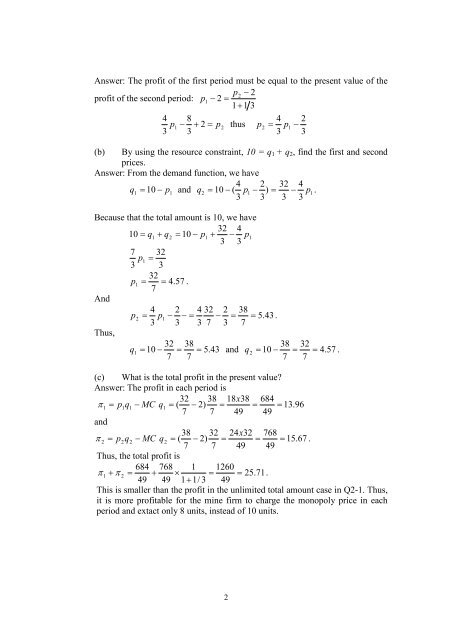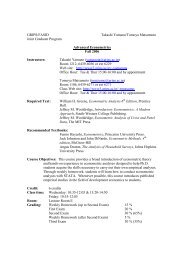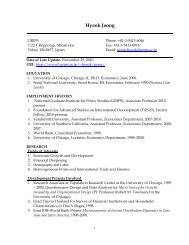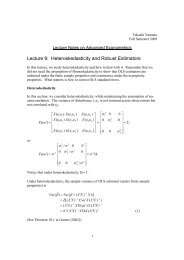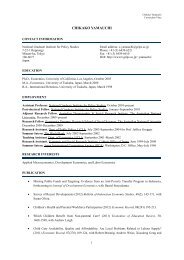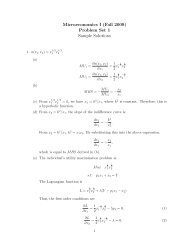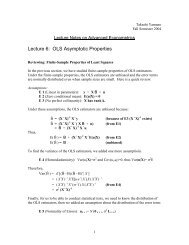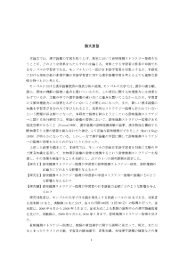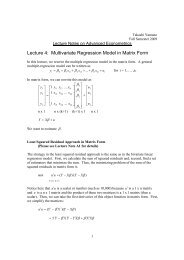Answer: The profit of the first period must be equal to the present value of thep2− 2profit of the second period: p1− 2 =1+1 34 84 2p1− + 2 = p2thus p2= p1−3 33 3(b) By using the resource constraint, 10 = q 1 + q 2 , find the first and secondprices.Answer: From the demand function, we have4 2 32 4q1 = 10 − p 1and q2= 10 − ( p1− ) = − p1.3 3 3 3Because that the total amount is 10, we have32 410 = q1+ q2= 10 − p1+ − p13 37 323p = 1332p1= = 4. 57 .7And4 2 4 32 2 38p2= p1− − = − = = 5.43 .3 3 3 7 3 7Thus,32 3838 32q1= 10 − = = 5.43 and q2= 10 − = = 4. 57 .7 77 7(c) What is the total profit in the present value?Answer: The profit in each period is32 38 18x38684π1= p1q1− MC q1= ( − 2) = = = 13.967 7 49 49and38 32 24x32768π2= p2q2− MC q2= ( − 2) = = = 15.67 .7 7 49 49Thus, the total profit is684 768 1 1260π1+ π2= + × = = 25.71.49 49 1+1/ 3 49This is smaller than the profit in the unlimited total amount case in Q2-1. Thus,it is more profitable for the mine firm to charge the monopoly price in eachperiod and extact only 8 units, instead of 10 units.2
3. Public Goods (24 points)1) The maximization problem is written as:Max w − g1)+ 2ln( g1+ g2) + ( w2− g2) + 2ln( g1+By taking the derivative with respect to g 1 (or g 2 ), we have2 2−1++ = 0.g1+ g2g1+ g2Rearranging givesG * = g1 + g2= 4.2) Individual 1’s maximization problem is:Max ( w1 − g1)+ a1ln( g1+ g2)So the first-order condition isa1−1+= 0,g + g(1g21from which we have individual 1’s reaction function: g1( g2) = a1− g2.Similarly,individual 2’s reaction function is given by g g ) = a − .22(1 2g1Case 1: a 1= a 2= aIn this case, the two reaction functions are identical. Thus, any pair ( g1,g2) thatsatisfies g 1+ g 2= a is a Nash equilibrium. In any equilibrium, a units of thepublic good is provided. If a = 2 for example, 2 units will be provided.Case 2: a1> a2In this case, the reaction functions of individuals 1 and 2 are respectivelyg1 ( g2) = a1− g2and g2( g1)= a2− g1. Suppose that individual 1 contributes g 1.First, if g1 ≥ a2, g 2( g 1) = 0 . Then, individual 1 contributes g1( 0)= a1.Therefore, a1is provided by individual 1.Next, if g1< a2, individual 2’s best response is to contributeg ( g = a − g . Let us g t ) denote the best response of individual 2 in2 1)212( g 112g1)round t. Then, we have g ( = a2− g1. Given g2= a2− g1, individual 1’sbest response is to contribute g1( a2− g1)= a1− a2+ g1. Given this, individual22’s best response is to contribute g2( a1− a2+ g1)= 2a2− a1− g1. If this isweakly less than zero, individual 2 contributes nothing, and individual 12contributes g1( 0)= a1. If g2> 0 , the process continues. In round t, individual2’s best response is expressed as g t2= ta2− ( t −1)a1− g1. Since a1> a2, theretexists t’ such that g2≤ 0 for all t ≥ t'. That is, the best response for individual 2at round t’ is contributing nothing. Given g 0 , individual 1 contributesg1( 0)= a1. (You can check that g t1= ( t −1)(a1− a2) + g1> 0 for all t.)You can also start with some 0 ≤ g2≤ 1 and get the same result. It is mucheasier to follow the process graphically and that suffices to solve this question.2=)3


